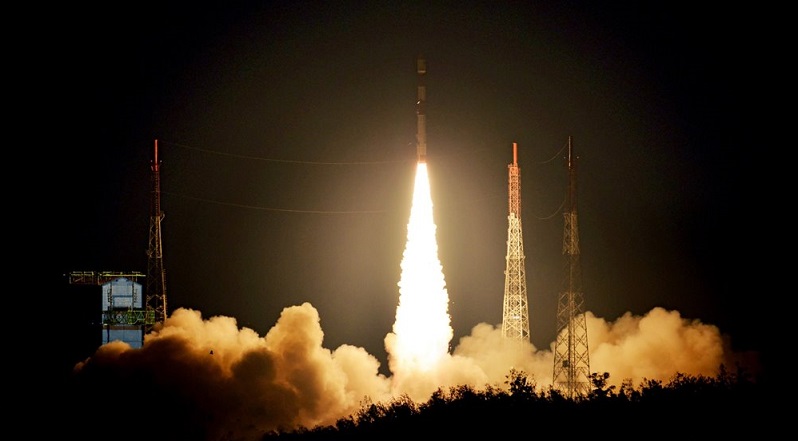A British-built radar satellite that will provide a host of benefits to life on Earth was successfully launched into space yesterday evening (Sunday 16 September) into a 580km sun-synchronous orbit from India’s Satish Dhawan Space Centre.
NovaSAR-1, designed and built by Surrey Satellite Technology Ltd (SSTL) in Guildford, will be able to see through clouds and image the world night and day.
The new spacecraft from SSTL will offer low cost remote imaging to global customers including the Commonwealth Scientific and Industrial Research Organisation (CSIRO) in Australia and the Indian Space Research Organisation (ISRO).
NovaSAR-1’s payload includes an S-Band SAR radar, which will open up new opportunities for monitoring environmental change, for example forest degradation, sea ice or flooding. SSTL is a great British success story: it already has 40% of the world’s small satellite export market.
Professor John Remedios, Director of the National Centre for Earth Observation welcomed the successful launch. He said:
“The importance of UK companies launching satellites with new technology for space cannot be underestimated, and therefore the launch of NovaSAR today is particularly significant.
UK capability in synthetic aperture radar is key to unlocking both enterprising business and excellent science. From ERS-1 in 1991 through to the forthcoming BIOMASS mission, the UK is delivering cutting-edge space missions.”
Forest biomass expert Professor Heiko Balzter, of NCEO – University of Leicester, said:
“We are tremendously excited about the launch of NovaSAR. It will provide S-band radar capabilities to the global observing system, opening up new avenues of monitoring forest degradation, oil spills, flooding and many other environmental issues.”

NovaSAR launches from India's Satish Dhawan Space Centre in Sriharikota, 16th September 2018. Credit: ISRO
Dr Graham Turnock, Chief Executive of the UK Space Agency, said:
“This exciting new satellite, with its powerful imaging radar system and compact design, has been developed and built in the UK, and will provide a host of benefits for applications including the detection of oil spills, flood monitoring and agriculture.
“The Government wants the UK to thrive in the commercial space age as part of the modern Industrial Strategy. This mission demonstrates SSTL’s world leading skills and the exciting potential for further growth in our sector.”
The UK is a world leader in Earth Observation technologies which have an increasing number of down to Earth applications, including through the UK Space Agency’s International Partnership Programme (IPP). This programme harnesses the expertise of the British space sector to tackle problems all around the world, from predicting dengue fever outbreaks in Vietnam to improving healthcare in Nigeria through satellite connectivity.
There is also a significant commercial opportunity, with Earth Observation satellite services estimated to support industries representing a total turnover of more than £235 billion.
Since 1981, SSTL has built and launched more than 50 satellites for 20 international customers including in Europe, USA and Canada – as well as providing training and development programmes, consultancy services, and mission studies for ESA, NASA, international governments and commercial customers.
International Trade Secretary Liam Fox recently launched the Department for International Trade’s first space export campaigns to target opportunities initially in the US and India.
The ‘Space Exports’ campaign will see 2 of the world’s fastest growing markets targeted with trade missions. In India the Department for International Trade (DIT) will also increase its operation by recruiting British space sector experts to work in market.
Minister of State for the Department for International Trade, Baroness Fairhead, said:
“SSTL is a fantastic example of how UK innovation and engineering can have a global impact. It is clear that our space industry is thriving, resulting in significant growth which reinforces the UK’s reputation as a leader in the sector.
“Overseas sales are vital to sustaining this growth, and our recently launched Export Strategy outlines the support available to companies to help them fulfil their exporting potential. I would encourage companies that are looking to follow in SSTL’s footsteps to make use of financial support from UK Export Finance and the extensive export opportunities that are listed on GREAT.gov.uk.”
The UK Space Agency has invested £21 million in the development of NovaSAR-1 and will benefit from access to data from the spacecraft, significantly boosting the UK’s sovereign Earth observation capabilities and leveraging additional inward investment to the UK by creating highly skilled jobs in the UK space industry.
NovaSAR-1 was designed and manufactured by SSTL, with an S-Band SAR payload developed by Airbus Defence and Space in Portsmouth and an Automatic Identification Receiver supplied by Honeywell Aerospace.
The BIOMASS mission, due to launch in 2021, is a P-band synthetic aperture radar. Its science lead is the NCEO scientist Professor Shaun Quegan of Sheffield University.